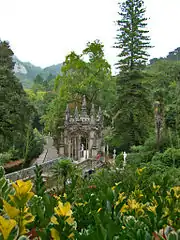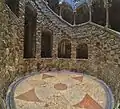| Quinta da Regaleira | |
|---|---|
.jpg.webp) | |
| General information | |
| Location | Sintra, Portugal |
| Part of | Cultural Landscape of Sintra |
| Criteria | Cultural: (ii), (iv), (v) |
| Reference | 723 |
| Inscription | 1995 (19th Session) |
| Type | Non-movable |
| Criteria | Monument of Public Interest |
| Designated | 19 February 2002 |
| Reference no. | IPA.00006705 |
Quinta da Regaleira [ˈkĩtɐ ðɐ ˈʁɨɣɐlɐjɾɐ] is a quinta located near the historic centre of Sintra, Portugal. It is classified as a World Heritage Site by UNESCO within the "Cultural Landscape of Sintra". Along with the other palaces in the area such as the Quinta do Relógio, Pena, Monserrate and Seteais palaces, it is considered one of the principal tourist attractions of Sintra.
The property consists of a Romantic palace and chapel, and a luxurious park that features lakes, grottoes, wells, benches, fountains, and a vast array of exquisite constructions. The palace is also known as "The Palace of Monteiro the Millionaire", which is based on the nickname of its best known former owner, António Augusto Carvalho Monteiro. The palace was designed by the Italian architect Luigi Manini.
History


The land that is now Quinta da Regaleira had many owners over the years. It belonged to the Viscountess of Regaleira, a family of wealthy merchants from Porto, when it was sold in 1892 to Carvalho Monteiro for 25,000 réis. Monteiro was eager to build a bewildering place where he could collect symbols that reflected his interests and ideologies. With the assistance of the Italian architect Luigi Manini, he recreated the 4-hectare estate.
In addition to other new features, he added enigmatic buildings that allegedly held symbols related to alchemy, Masonry, the Knights Templar, and the Rosicrucians. The architecture Manini designed evoked Roman, Gothic, Renaissance, and Manueline styles. The construction of the current estate commenced in 1904 and much of it was completed by 1910.
The estate was later sold in 1942 to Waldemar d'Orey, who used it as private residence for his extensive family. He ordered repairs and restoration work for the property. In 1987, the estate was sold, once again, to the Japanese Aoki Corporation and ceased to serve as a residence. The corporation kept the estate closed to the public for ten years, until it was acquired by the Sintra Town Council in 1997. Extensive restoration efforts were promptly initiated throughout the estate. It finally opened to the public in June 1998 and began hosting cultural events. In August of that same year, the Portuguese Ministry of Culture classified the estate as "public interest property".[1]
Palace
The Regaleira Palace (Portuguese: Palácio da Regaleira) bears the same name as the entire estate. The structure's façade is characterised by exuberantly Gothic pinnacles, gargoyles, capitals, and an impressive octagonal tower.
The palace contains five floors (a ground floor, three upper floors, and a basement). The ground floor consists of a series of hallways that all connect the living room, dining room, billiards room, balcony, some smaller rooms, and several stairways. In turn, the first upper floor contains bedrooms and a dressing room. The second upper floor contains Carvalho Monteiro's office, and the bedrooms of female servants. The third upper floor contains the ironing room and a smaller room with access to a terrace. Finally, the basement contains the male servants' bedrooms, the kitchen (which featured an elevator for lifting food to the ground floor), and storage rooms.
 The main façade of the palace.
The main façade of the palace. The main entrance to the palace.
The main entrance to the palace. The balcony.
The balcony. Turret with Manueline symbols alluding to the Portuguese discoveries.
Turret with Manueline symbols alluding to the Portuguese discoveries. The fireplace in the dining room.
The fireplace in the dining room. The living room.
The living room. Entrance to the spiral stairwell.
Entrance to the spiral stairwell.
Chapel
The Regaleira Chapel is a Roman Catholic chapel, and stands in front of the palace's main façade. Its architecture is akin to the palace's. The interior of the chapel is richly decorated with frescoes, stained glass windows and lavish stuccoes. The frescoes contain representations of Teresa of Ávila and Saint Anthony, as well as other religious depictions. Meanwhile, the floor itself offers depictions of the armillary sphere of the Portuguese discoveries and the Order of Christ Cross, surrounded by pentagrams. Despite its relatively small size, the chapel has several floors.
 The main entrance.
The main entrance. The side entrance.
The side entrance. Stuccoes above the main entrance.
Stuccoes above the main entrance. The interior of the chapel.
The interior of the chapel.
 Frescoes depicting Teresa of Ávila and Saint Anthony (during his "Sermon to the Fish", by Father António Vieira).
Frescoes depicting Teresa of Ávila and Saint Anthony (during his "Sermon to the Fish", by Father António Vieira). The floor: Order of Christ Cross over the armillary sphere.
The floor: Order of Christ Cross over the armillary sphere. Side view of the chapel.
Side view of the chapel.
Park

Buildings- A) Regaleira Palace; B) Regaleira Chapel; C) Greenhouse; D) Cultursintra Foundation offices; E) Coach Houses; F) Arts Workshop; K) Regaleira Tower;
Open-air structures- G) Chimeras' Court; H) Loggia; I) Ibis Fountain; J) Fountain of Abundance;
Fields- L) Terrace of the Celestial Worlds and Reservoir; M) Guardians' Entrance; N) Threshold of the Gods; O) Tennis Court;
Others- 1) Main gate; 2) Secondary gate; 3) Upper gate; P) Aquarium; Q) Initiation Well; R) Unfinished Well; S) Labyrinthic Grotto; T) Leda's Grotto; W) Eastern Grotto; X) Grotto of the Virgin;
Lakes- U) Unnamed Lake; V) Waterfall Lake;
Much of the four hectares of land in the surrounding estate consists of a densely treed park lined with myriad roads and footpaths. The woods are neatly arranged in the lower parts of the estate, but are left wild and disorganised in the upper parts, reflecting Carvalho Monteiro's belief in primitivism. Decorative, symbolic, and lively structures can be found throughout the park.
 Gazebo on the ornate bridge over the lower gate.
Gazebo on the ornate bridge over the lower gate. Bench between the lake and the Loggia.
Bench between the lake and the Loggia. Bench between the lake and the Ibis Fountain.
Bench between the lake and the Ibis Fountain. Bench between the chapel and the palace.
Bench between the chapel and the palace.
Tunnels
The park also contains an extensive and enigmatic system of tunnels, which have multiple entry points that include: grottoes, the chapel, Waterfall Lake, and "Leda's Cave," which lies beneath the Regaleira Tower. The "Initiation Well" (see next section) connects to other tunnels via a series of underground walkways.[2]
 Entrance to the Labyrinthic Grotto.
Entrance to the Labyrinthic Grotto. The Labyrinthic Grotto seen from the lake.
The Labyrinthic Grotto seen from the lake. Tunnel starting from the Eastern Grotto.
Tunnel starting from the Eastern Grotto. Leda's Cave.
Leda's Cave.
Initiation Wells
The Initiation Wells (also called initiatic wells or inverted towers) are two wells on the property that better resemble underground towers lined with stairs. These wells never served as water sources. Instead, they were purportedly used for ceremonial purposes. The tunnels described above connect these wells to one another, in addition to various caves and other monuments located around the park.
Of the two wells, the larger one contains a 27-metre spiral staircase with 23 small niches on the side. The nine flights of stairs could be linked to the Knights Templar, which had nine founders.[3] They might also symbolize the 9 churches of Hell from Dantes’ Inferno.[4] At the bottom of the well is an inland stone compass with the Templar cross.[4] Other references may be to Freemasonry, Rosicrucianism rituals.
Carvalho Monteiro was possibly an initiate of the Knights Templar, a Catholic military order. This medieval order originated in the early 1100’s and likely disbanded in the 1300’s. However, groups like the Freemasons revived their rituals and traditions hundreds of years later. It is believed that initiations at Quinta da Regaleira began with blindfolded candidates entering one of the wells. They purportedly held a sword close to their heart and descended the 9 flights of stairs. Once they reached the bottom of the well, they walked into a dark labyrinth and needed to find their way up towards the light then to the chapel, where they were welcomed into the brotherhood.[3]
The smaller well contains straight stairs that connect a series of ring-shaped floors to one another.[5] This well is also called the 'Unfinished Well'.
 Bottom of the Initiation well.
Bottom of the Initiation well. Looking down the Initiation well.
Looking down the Initiation well. View upwards from the bottom of the Initiation well.
View upwards from the bottom of the Initiation well. Rain down the Initiation well.
Rain down the Initiation well.
Lakes, fountains, and the aquarium
Bodies of water can be found in several places in the park. Two artificial lakes and several fountains were added by Monteiro. One of the most interesting and extravagant among them is the Aquarium, built as if it were naturally embedded in a large boulder. It was once considered the most important naturalist property in Regaleira. However, the Aquarium is no longer used and is poorly maintained.
 The Ibis Fountain.
The Ibis Fountain. The Fount of Abundance.
The Fount of Abundance. The Waterfall Lake as seen from the Terrace of the Celestial Worlds.
The Waterfall Lake as seen from the Terrace of the Celestial Worlds.
See also
References
- ↑ Taurino, João. "Palace and Quinta da Regaleira - Visit Sintra". visitsintra.travel. Retrieved 2023-05-12.
- ↑ "Inside the Initiatic Well - Picture of Quinta da Regaleira, Sintra - TripAdvisor". www.tripadvisor.com.
- 1 2 Cardosa, Fernando Teixeira & Izabela. "The mysterious inverted tower steeped in Templar myth". www.bbc.com. Retrieved 2023-05-12.
- 1 2 "Templar Secrets of Sintra's Mysterious Initiation Well". Messy Nessy Chic. 2023-02-17. Retrieved 2023-05-12.
- ↑ Tom. "Quinta da Regaleira: Occult Initiation Wells Steeped in Mysticism". Urban Ghosts. Retrieved 4 May 2018.
- Portuguese Association for Investigation
- "Rotas & Destinos" magazine
- Quinta da Regaleira: Sintra Portugal. Fundação Cultursintra
- Anes, José Manuel (1998, interviewed by Victor Mendanha). O Esoterismo da Quinta da Regaleira. Lisbon: Hugin
- Anes, José Manuel (2005). Os Jardins Iniciáticos da Quinta da Regaleira. Lisbon: Ed. Ésquilo
- Adrião, Vitor Manuel (2006). Quinta da Regaleira: A Mansão Filosofal de Sintra. Lisbon: Via Occidentalis Editora
- Veigas, Ana Sofia Fernandes (2007), Para uma Antropologia do Símbolo Estético: o paradigma da Quinta da Regaleira, Lisbon, Faculdade de Letras da Universidade de Lisboa
